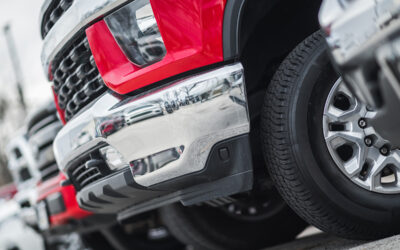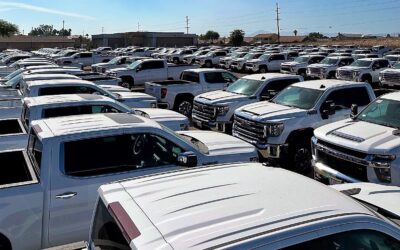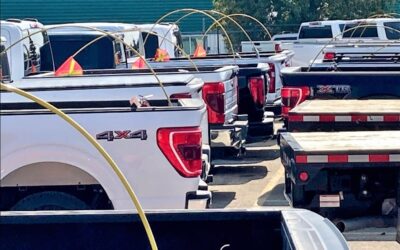Build Your Commercial Fleet: Truck Lease vs. Buy
Whatever your business, building a fleet of vehicles can be costly and take a lot of time. There are essentially three ways to go about building a fleet of vehicles. You can buy, lease, or rent them. Of course, there are pros and cons of each option, and some real benefits for one over the other. Which one is right for you? It will depend largely on what you use the vehicles for, how often you use them, and whether or not your fleet is location dependent.
For many contractors and other businesses, rentals make more sense than buying much of the time. Why? It’s some pretty simple math, actually. Here is part of the breakdown of the benefits of renting vs. buying your fleet vehicles.
Overall Costs
Quite often the reason for choosing one method over another comes down to cash: how much money does it cost? Depending on the purpose of your fleet, it may be beneficial to rent over owning due to the sum of costs such as payments, maintenance, repairs, insurance and licensing. While it may seem at first glance like renting vehicles would be costlier than owning them, let’s look at a breakdown of the numbers.
- Payments: Typically, payments for vehicles take up a lot of your budget, and you are paying interest on those loans too. The overall cost can be considerably more than the price of the vehicle itself.
- Maintenance: We will look at this in more detail in a moment, with some real-world numbers, but the cost of maintaining vehicles, even a small fleet, can involve some significant costs.
- Repairs: Who covers the cost if something breaks? A rental vehicle is not yours, and often you can have a replacement in hours if something needs to be repaired. With a purchased vehicle, even one with a warranty, you could be out of that vehicle the whole time it is being repaired and you will pay for the fix as well.
- Insurance and Licensing: Even with the best-case scenarios, the cost of annual licensing and insurance can be a real burden on any business. We will look at this in more detail below as well.
There are other factors that will affect the real overall cost of owning your own fleet of vehicles vs. renting them. For the moment, let’s look at the real-world numbers that surround some basic fleet ownership costs.
Maintaining a Fleet
This is one of the largest costs of owning your own fleet of vehicles. Let’s say you are using four-wheel drive diesel trucks in your business to haul around equipment and personnel. What are some of the costs associated with those trucks?
Oil Changes
The average cost of a diesel oil change is $50-$70 dollars depending on where you have it done. Even if you have a regular mechanic who gives you a discount, you will still have to pay for his time. Let’s say instead that you hire your own mechanic to maintain your fleet. If you are paying that person $35 dollars an hour, by the time you pay for oil and filters, you are still paying around the same cost.
Even if you stretch these oil changes to every 5,000 miles, at average fleet truck use rates of 20,000 miles per year, you are paying around $70 every three months per vehicle in your fleet, not to mention any other fluids and oil added between changes. Even if generously that is $30 per quarter, your vehicle cost just for oil changes is $30 a month.
Tires
Let’s say your tires cost you $1,500 each time you replace a set. If you are running dually tires on the rear, that can be more like $2,000. Even if you only replace tires every two years per vehicle, which is better than average for fleet tires, the cost breaks down to a little less than $100 a month per vehicle.
This scenario of course is if nothing goes wrong, and you have zero flats or blowouts, or any of the other common issues found on a job site. If you have a puncture in a tire sidewall for any reason, you will be replacing it. That cost comes in addition to simply regular tire changes and rotations.
Even if you are paying your own mechanic to rotate your tires or you are getting them rotated elsewhere, this is an additional expense and time-consuming effort.
Repairs
Mentioned briefly above, this bears repeating here. If your vehicles are still under warranty, some repairs will be covered, but there are often special rules that come with fleet warranties that govern exactly what they will cover. Certain repairs will be your responsibility.
Reliable trucks might need a few repairs per year, but this is one of the costs that is hard to predict. Some months you may have no repairs at all, others you will have several repairs and have to deal with downtime of your vehicles.
With all of the above expenses, there is one other expense for you to consider: you must either replace the truck that is down for maintenance or repair, or you must run without it. Either way, it is costing you money. Of course, if you are renting trucks in the first place, you can have a replacement while the rental is being repaired, and the downtime has little or no effect on your overall costs.
Licensing and Insurance
This can be another big variable depending on your state of residence and primary use, but fleet vehicles often require commercial licensing. That licensing often comes with additional fees based on the weight you carry, the use of your vehicle, if you tow a trailer or not, and others. The point is that it will cost a lot more to license your commercial fleet than it will your car, and those are annual costs.
Of course, for rental vehicles, those costs are built in to the cost of the rental, and you don’t have to worry about them yourself. Think of it this way. Commercial vehicle licensing in even a relatively low-cost state like Idaho can run around $400 per vehicle, per year. In some states that cost can be upwards of $1,000 when you add in all the fees required. When you start to multiply this out even across a small fleet, it adds up quickly.
Then there is the dreaded subject of insurance. Depending on your state requirements and what you are doing, you will have to insure your vehicles, and the standards are higher than they are for your personal vehicle. This is because your risk is perceived to be greater. A heavier vehicle can do more damage in an accident, and you probably have multiple drivers on your staff, any of whom are authorized to drive your fleet vehicles.
Depending on the driving records of that staff and the safety record of your company, this can be a significant cost. Most commercial fleet rental companies require the “renter” to have their own insurance, so you may not see particular savings in that area. Encouraging safe driving and pre-screening drivers in your fleet should be a high priority.
Insurance is another fleet cost that varies greatly and can increase dramatically with any accident. Managing this cost effectively can be a real challenge even with a great insurance agent and a good company to work with.
The average insurance rate for a fleet truck will range from $800 to $2,000 per month, more than what it costs to ensure most passenger vehicles for an entire year. This is the cost per vehicle, so even a small fleet can run around $5,000-$7,000 per month.
Licensing and insurance costs are just the beginning though, and when those costs are covered by a rental company instead, rental options look even more attractive. Still, there are even more costs to consider when discussing rental vs. buying options for your fleet vehicles.
Transporting a Fleet to New Locations
Let’s say you have a contracting company based in Nevada but you get a job in North Dakota doing some work there. If you own your fleet, you will need to transport both men and vehicles to the new location. There are of course several ways to do so.
Shipping by Rail
This method is common with the US Military and some larger organizations for whom fleet rental on-site is not an option. The cost will depend largely on the time of year but will range from $800 to $1,500 per vehicle depending on the distance. Costs are lower in the winter —when business is slower— and more expensive in the summer when demand is high.
Shipping by Truck
Surprisingly, shipping by truck will have a similar cost to shipping by rail. The difference is that if there is not a railhead near the job you are taking, you will have to drive your vehicles for a distance or arrange another alternate form of transportation to the site. With shipping by truck, vehicles can be delivered directly to the site, and personnel can be transported by plane or other methods.
Arranging a Convoy
The final way to get vehicles to a new job site is by arranging for a convoy, or essentially driving from where you are now to where the job is. This is cos- effective if the distance is short enough, as the men and the vehicles are transported at the same time. However, the cost of fuel, mileage, and wear and tear on vehicles quickly adds up.
If you travel frequently to various jobs in various locations, renting your fleet is a good idea simply because you can pick up trucks where you are going, get work done, and return them when the job is over. There is no extra transportation cost to deal with.
Another aspect of renting a fleet on-site is that you avoid possible damage. As careful as shippers try to be, damage is always possible, and even if insurance will cover the cost, you will be without the vehicle while it is being repaired or replaced. If you are on a time-sensitive job, this can be not only costly but devastating.
When you work in remote locations, unless you have fleet vehicles that are specifically designed and difficult to find for rent, renting is almost always the best option for your company and your team.
Idle Vehicle Costs
Let’s say you have several vehicles, but they sit idle when you are not busy. This is a cost that, while often ignored, can be huge. The reason? For many vehicles, it is harder for them to sit rather than be used. Seals deteriorate, fuel can go bad, and fluids need to be changed and maintenance performed anyway.
Remember earlier when we talked about the cost of tires? Tires that sit often experience dry rot and cracking, and if they are in the sun they can become damaged even further. They can become dangerous and need to be replaced long before their useful life is really reached.
The appearance of a vehicle, unless it is covered or at best garaged can be harmed by sitting for long periods as well. Dash and plastics can crack and become brittle, paint and frame pieces fade, and other items like decals are sun damaged.
From bearings to u-joints and fluid changes it can be quite costly to bring a vehicle back into service after it has sat idle for a long time. If you have certain vehicles you use that are likely to sit idle for long periods of time, renting makes a lot more sense than purchasing them.
Vehicle Storage
Much like the vehicles in your fleet themselves, there are two ways to handle vehicle storage. You can either purchase storage and store them on your own property or in your own buildings, or you can rent vehicle storage space. Either way, this is an expense that adds up quickly.
The average vehicle storage space is $150-$200 a month in a reputable, trustworthy storage area. Even if you are able to rent from another company that has some available space, the costs will likely be similar, and security is a genuine concern. Not only do you need to secure vehicles, but the things that are in them and any tools that your employees use with them.
Of course, you can either rent a lot or a warehouse for your vehicles instead. However, the cost for this space goes beyond just a place to house your fleet. You then need insurance and again security. You will need cameras, alarms, and perhaps even a security company to patrol the area when you are not there.
In this case, think of just the business insurance to cover one million dollars’ worth of equipment, a relatively low amount when you add in fleets of vehicles. Add this to rent, security monitoring, and more and you are into thousands a month very quickly.
Once your fleet is large enough and stationary enough, you can hire your own mechanics, have your own shop on site, and even own your own business property. Even then, the margins you are working with will be very thin, and you still may be better off renting fleet vehicles instead.
Because you simply rent vehicles and then return them, the rental company covers the costs of storage and the security and other costs that go with it.
Updating your Fleet
Let’s say that you do buy your vehicles. Whether you make payments or purchase them outright, there will be some advantages and disadvantages of doing so, from tax savings to all of the costs mentioned above.
The kicker though is that at some point you will need to update your fleet. Vehicles will age, and once they reach a certain point will need to be replaced. Some companies do this in stages, replacing some vehicles every other year, and others every five years or so depending on mileage and use.
In some cases, your needs will change and you will need to replace vehicles sooner with updated features and equipment. This means either a new loan, a large expense, or exploring other options.
In this case, since fleets are rapidly changing or in need of updating or replacement, it may be best to rent the fleet instead. Rental companies are always updating their fleets and keeping the latest vehicles in stock. They often sell vehicles annually or biannually once they reach a certain age. As fleet needs evolve, they evolve with them.
Not only will you be saving on updating your fleet, you’ll also be avoiding the costs of depreciation. When you purchase a vehicle, it will immediately begin to lose value and depreciate in costs. When you lease trucks, the depreciating value will not affect you or the net worth of your company.
Are there instances when buying your fleet vehicles makes sense? Of course. If you have special needs or outfit your trucks or cars in a specific way that cannot be duplicated on rental vehicles, of course purchasing them is a better option. Purchasing a fleet vehicle provides less flexibility and savings than leasing in certain instances. However, if you simply need a vehicle to transport goods, tow a trailer, or haul and do simple tasks on a job site, rental vehicles make a lot of sense, and may be the best option for building your fleet.In some cases, hybrid options make sense as well. You may want to purchase some vehicles as your needs expand for your fleet but rent vehicles you need less often or on specific job sites. Either way, there are many costs to consider when building your fleet, and renting is often less expensive in the long term. Use this guide to help you determine whether a truck lease vs. buy will work best for you and your business. Have more questions about fleet building? Contact us to learn more today.






